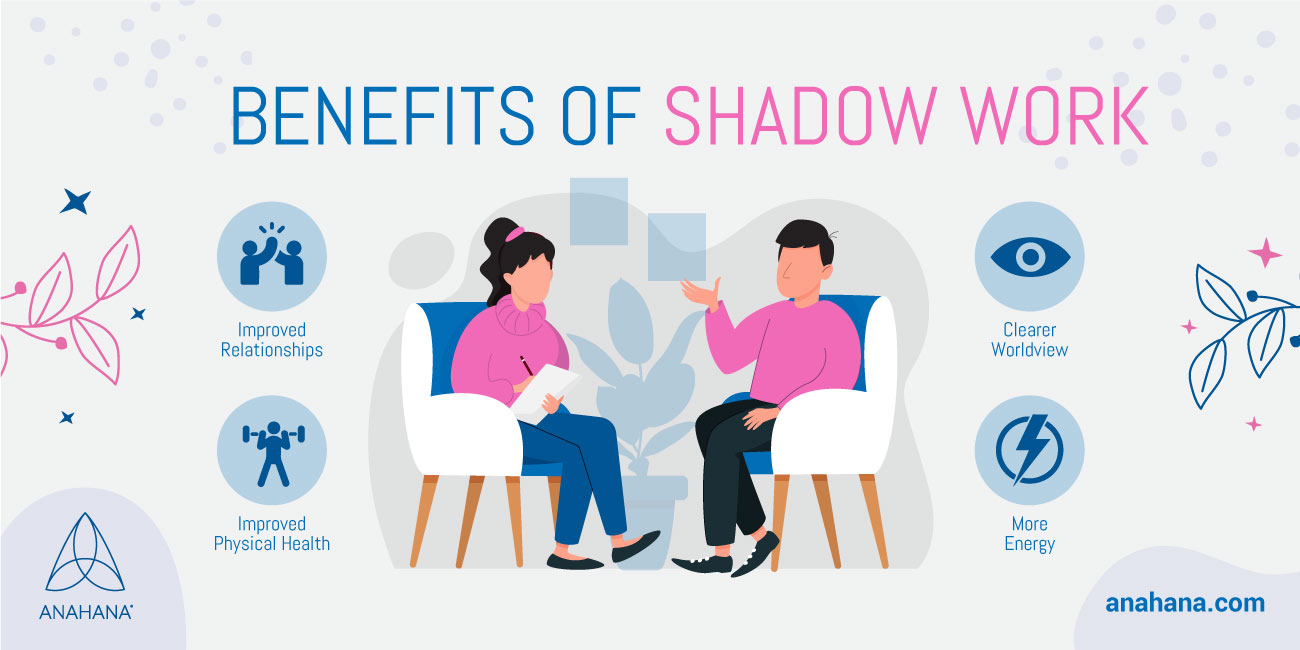
Table of Contents
Uncovering the inner self and understanding the shadow aspects of it is a powerful practice that can lead to personal growth. Learn more about different types of therapy practices that focus on shadow work, as well as the benefits of working with your own shadow.
Shadow Work Explained
Shadow work is a type of psychotherapy that uses various practices to help individuals accept and integrate their shadow self to thrive with greater authenticity and clarity.
Shadow work aims to assimilate the persona and shadow so a person learns to manage impulses they usually ignore, such as greed or anger. Shadow work brings the suppressed parts of the personality into an individual’s consciousness so they can learn to accept the hidden self.
Shadow work can also be considered trauma work as it also heals the wounded parts, as most shadows are created due to childhood or attachment trauma. The shadow self-developed in early childhood becomes a permanent part of the individual’s personality.
Shadow work involves reflecting on one’s childhood experiences as often triggers and behaviors of individuals as a child influence their shadow selves.
What is the Inner Shadow or Shadow Self?
 Individuals possess traits they are not so confident about, or it might trigger or embarrass them; therefore, they are buried deep in the unconscious mind, hidden from public view. These parts refer to an individual’s shadow self or inner shadow.
Individuals possess traits they are not so confident about, or it might trigger or embarrass them; therefore, they are buried deep in the unconscious mind, hidden from public view. These parts refer to an individual’s shadow self or inner shadow.
The shadow includes the dark sides or disowned parts of an individual’s personality because it consists of negative human emotions and impulses, including striving for power, greed, envy, rage, desire and selfishness.
Not everyone can come to terms with their shadow self, and they repress the hidden parts of themselves and avoid confronting the darker side. Although the shadow still exists, it gets forgotten.
Repressing an individual’s inner shadow can have adverse consequences. The shadow often manifests as triggers or emotional reactions under the wrong circumstances.
Self-awareness, training, courage and guidance are ways for individuals to shape their shadow self healthily.
The components of an individual’s shadow depend on the feelings individuals subconsciously reject within themselves, usually as negative self-talk.
History of the Shadow Self
 Psychologist Carl Jung popularized the idea of the inner shadow and defined the collective unconscious using eight different Jungian archetypes.
Psychologist Carl Jung popularized the idea of the inner shadow and defined the collective unconscious using eight different Jungian archetypes.
The eight traits, as defined by Jung, include the self, which is the conscious awareness or the center of an individual’s psyche or personality, shadow which is the emotional or dark aspect of an individual’s psyche, anima which is the image of the idealized woman that draws individuals into their feminine side.
Carl Jung’s other traits include animus, part of an individual with a capacity for self-knowledge and reflection; persona, the masks individuals wear to protect their inner selves and show the world; hero, the part of an individual’s psyche that can overcome destruction and evil; trickster, a childish part of an individual’s psyche; and wise old self, a personification of an individual’s self that contains wisdom.
Jung deemed the shadow archetype as an individual's inferior or immoral side, but that is not always true. He theorized that it is opposite to the persona, the self that people present to others.
However, Jung believes that the shadow self also has the potential for positive impulses and feelings besides negative impulses. Therefore individuals must interact with and accept their shadow selves.
The Role of the Subconscious Mind
The subconscious mind can be called the shadow because individuals cannot see it clearly and thus are unaware of it. The conscious mind is akin to the light because individuals are aware of it and can view it more clearly.
The subconscious comprises all that individuals reject about themselves. Exploring the subconscious through shadow work allows individuals to heal much deeper.
How the Inner Shadow Affects Individuals
Ignoring the shadow side can adversely affect an individual’s well-being as this part of an individual's craves to be explored and understood. Individuals feel emotionally and mentally strong when the shadow is not integrated into them.
Although individuals ignore their inner shadow, the shadow will find ways to highlight its existence. Some issues avoiding the inner shadow include poor self-esteem, anxiety and depression, self-deceit and deceiving others, depression and anxiety, inflated ego, offensive behavior, and struggling with healthy relationships.
Another critical effect of ignoring one’s inner shadow is projection. The quality that individuals deny within themselves, they see in others. Projection is an unconscious process. The egos of individuals use this mechanism to defend how it perceives themselves.
The psychological projections distort reality creating a boundary between how individuals view themselves and how they behave. Individuals begin projecting their disowned parts onto others.
Benefits of Shadow Work
 Shadow is a concept that cannot be tangibly measured, is subjective, and varies based on context. Traits, values, or beliefs that are socially acceptable in one culture might not be acceptable in another, which affects whether they become part of an individual's shadow self.
Shadow is a concept that cannot be tangibly measured, is subjective, and varies based on context. Traits, values, or beliefs that are socially acceptable in one culture might not be acceptable in another, which affects whether they become part of an individual's shadow self.
Although little scientific research exists on how effective shadow work is, most research focuses on how individuals use shadow work to solve certain challenges. Exploring the shadow self through shadow work provides an opportunity for personal growth and development.
Improved Relationships
There are several benefits of shadow work. Firstly, shadow work helps improve relationships. Relationships are improved because individuals come to terms with their inner shadow, viewing themselves more clearly.
Once individuals learn to be more accepting of themselves, it will be easier for them to accept the shadow in others and not be triggered by the darker sides of their personalities, regardless if that is the shadow of family members, friends, business partners or spouses.
Shadow work fosters self-awareness and better relationships through improved emotional health.
Clearer Worldview
The second benefit of shadow work is having a clearer view of the world. As individuals integrate their shadow selves, they approach their authentic selves, giving them a more realistic assessment of who they are.
When individuals possess more self-awareness, they can assess the environment more accurately. They will also evaluate and approach social situations with understanding, compassion, and greater clarity.
Individuals can free themselves from the unconscious shadow that controls them, empowering individuals, especially those with lower self-esteem, as they hide the positive qualities they possess in their shadow.
Improved Physical Health and Energy
It can be exhausting for individuals to continuously suppress all parts of themselves that they don’t want to face during adulthood. Individuals’ lives can be plagued by lethargy and fatigue, and mental suppression can cause physical disease or pain.
Studies show that thousands of chronic back pain patients have healed by acknowledging the repressed rage in their unconscious.
Shadow work allows individuals to liberate the energy that individuals invest in protecting the repressed parts of their personality, which can help improve emotional, physical and mental health.
Ways to Practice Shadow Work
 Only a few individuals are aware of shadow work as psychotherapy. It starts with an individual being willing to explore their shadow self despite being uncomfortable.
Only a few individuals are aware of shadow work as psychotherapy. It starts with an individual being willing to explore their shadow self despite being uncomfortable.
Shadow work prompts and exercises help bring the unconscious to conscious awareness, which is important to maintain psychological health. This is typically done with a Socratic approach of exploration and questioning.
The Socratic approach involves asking objective questions to elicit critical thinking and helps individuals reexamine old beliefs and stories individuals hold about themselves. The idea is that the licensed therapist or the objective entity can provide an interpretive mirror for individuals.
Some strategies to do that include journaling, which can help individuals explore and collect their unconscious thoughts and desires by searching for themes and patterns. An individual might follow prompts or write stories in a journal.
Dream analysis and psychoanalysis are other ways to engage in shadow work. Dreams are tools for accessing the shadow self and unconscious. Individuals can find repeating dreams and themes to see whether individuals notice aspects of themselves they ignore.
Not always advisable or even possible to do shadow work by themselves. Individuals with severe trauma or mental health concerns require support from professionals.
Shadow Work for Beginners
For beginners, the three steps to understanding shadow work include encountering the shadow, merging with the shadow, and assimilation of the shadow.
Encountering the Shadow
An active imagination is the most essential part of practicing shadow work through meditation and daydreaming. The experience is mediated by interpretation through various forms of art and narrative, including dancing, singing, poetry, pottery and singing. Psychoanalysts perform dreamwork to raise the unconscious to conscious awareness.
The encounter with the shadow is a central part of individuation or breaking down an individual’s persona. Encountering the shadow means that individuals deny the embarrassing impulses and qualities in themselves but can see those qualities in others, including greed, egotism, mental laziness, unreal schemes, plots, and fantasies.
Individuals begin to be judgemental of these qualities and traits in others. The projections can be on internal dream figures or external figures.
The individuation process and dissolution of the persona begin with the projection and encounter of the shadow.
Merging with the Shadow
According to Jung, the shadow can overwhelm individuals’ actions, especially when the conscious mind cannot make decisions because it becomes trapped in the shadow. The shadow part takes over when the individuals get triggered.
As the process continues, the libido sinks into the shadows of the unconscious, and what becomes visible externally is the shadow that was hidden under the mark, and the shadow comes into the light. The shadow and the ego are no longer separate but are merged together into a single unity.
The interaction between the two can hamper moral decisions at first. However, with strength and courage over time, individuals can overcome the consequences, and the shadow can become a personality.
Assimilation of the Shadow
Assimilation of the shadow means retaining awareness of the shadow and incorporating the shadow into an individual’s personality, generating a stronger consciousness. Realizing the personal unconscious is the first stage in the quest for individuation.
The shadow is a place of creativity, for some individuals, the dark side of their beings represents the true spirit of life. Therefore, acknowledging the shadow is a continuous process throughout an individual’s life.
Shadow Work Exercises
 Shadow work exercises focus on bringing an individual into the light that was previously concealed in the dark. Individuals must engage in shadow exercises to begin the process independently.
Shadow work exercises focus on bringing an individual into the light that was previously concealed in the dark. Individuals must engage in shadow exercises to begin the process independently.
Individuals can do this by considering what they fear the most, what brings shame to them, what triggers them, what their life experiences were like, what makes up their shadow side, and whether they recognize their self-sabotaging habits and behavior.
Individuals must let go of the fear, pain or suffering from their inner shadow and focus on confronting their challenges and experiences as a practice of healing.
Shadow Work Tips and Prompts
Individuals might require the assistance of a trained practitioner, Jungian psychoanalysts, or someone with experience practicing more contemporary versions of shadow work. A therapist can help clients with making the unconscious conscious. However, it might be difficult to find a specialist because shadow work is uncommon.
Some beginner tips include practicing spotting the inner shadow, thinking about triggers, reflecting on past trauma, confronting one’s shadow and meditation.
Inner work requires engaging in inner dialogue, listening to one’s thoughts and processing feelings in an unfiltered and raw manner can help individuals address the most intimate parts of their psyche.
Other tips for beginners starting shadow work include taking a gradual approach, showing self-love, practicing self-compassion, self-acceptance, self-compassion, self-reflection and self-care, and having a spirit of acceptance and curiosity.
Paying attention to one’s shadow is critical as it can help individuals see the rejected aspects of themselves and help them move forward.
Steps After the Shadow Work
When individuals start shadow work, they may feel the emotions they suppressed as a child. Shadow work helps bring the unconscious into consciousness by addressing past pain, insecurities, negative impulses, and regrets that individuals have concealed from their inner self and the outer world.
By implementing shadow work, individuals can heal and transform their lives and develop a strong sense of self-awareness through addressing and coping with negative emotions that make up one’s shadow side.
Once individuals discover their inner shadow, it is critical not to blame or shame it; instead, accept it and move forward. Individuals will become increasingly aware of their triggers, their emotions, thoughts and feelings.
References
A Definitive Guide to Jungian Shadow Work: How to Get to Know and Integrate Your Dark Side
What is shadow work? Benefits and exercises.
Shadow Self and Carl Jung: The Ultimate Guide to the Human Dark Side | HighExistence
8 Benefits of Shadow Work and How to Start Practicing It
Shadow (psychology) - Wikipedia
DISCLAIMER
The contents of this article are provided for informational purposes only and are not intended to substitute for professional medical advice, diagnosis, or treatment. It is always recommended to consult with a qualified healthcare provider before making any health-related changes or if you have any questions or concerns about your health. Anahana is not liable for any errors, omissions, or consequences that may occur from using the information provided.

By: Anahana
The Anahana team of researchers, writers, topic experts, and computer scientists come together worldwide to create educational and practical wellbeing articles, courses, and technology. Experienced professionals in mental and physical health, meditation, yoga, pilates, and many other fields collaborate to make complex topics easy to understand. Anahana is also home to specialists in crystals, tarot, angel numbers, astrology, life path numbers, zodiac signs, and horoscopes. By combining evidence-based wellness with spiritual and energetic practices, the team offers clear, trustworthy guidance for both mind-body health and modern spirituality.